The Canon AE-1 Program is a 35mm SLR film camera released in 1981, offering three operation modes: Program, Shutter-Speed Priority, and Manual. It features a Central Processing Unit (CPU) for enhanced functionality.
1.1 Overview of the Canon AE-1 Program
The Canon AE-1 Program is a 35mm SLR film camera introduced in 1981, designed for both amateur and professional photographers. It combines ease of use with advanced features, offering three operating modes: Program, Shutter-Speed Priority, and Manual. The camera features a Central Processing Unit (CPU) for enhanced functionality and compatibility with Canon FD lenses. Its ergonomic design and intuitive controls make it a versatile tool for various photography needs. The AE-1 Program is celebrated for its reliability and adaptability, making it a favorite among photographers seeking precision and creativity in film photography.
1.2 Historical Background and Development
The Canon AE-1 Program was introduced in 1981 as an evolution of the original AE-1, launched in 1976. The AE-1 series was groundbreaking, blending advanced electronics with mechanical reliability. The Program version added a CPU for enhanced functionality, offering three operating modes: Program, Shutter-Speed Priority, and Manual. This innovation made it versatile for both amateur and professional photographers. Its development marked a significant step in Canon’s pursuit of user-friendly, high-performance cameras.
The AE-1 Program became iconic, combining robust construction with intuitive controls. Its release solidified Canon’s reputation in the photography world, influencing future camera designs and remaining popular among film enthusiasts today.
1.3 Target Audience and Usage
The Canon AE-1 Program was primarily designed for amateur photographers but also appealed to professionals seeking a reliable, versatile tool. Its intuitive design and advanced features made it ideal for a wide range of photography applications, from casual snapshots to creative projects. The camera’s three operating modes—Program, Shutter-Speed Priority, and Manual—catered to both beginners and experienced users, offering flexibility and control. Its compact size and robust construction made it a popular choice for everyday use, travel, and artistic expression, solidifying its place as a beloved camera among photography enthusiasts.
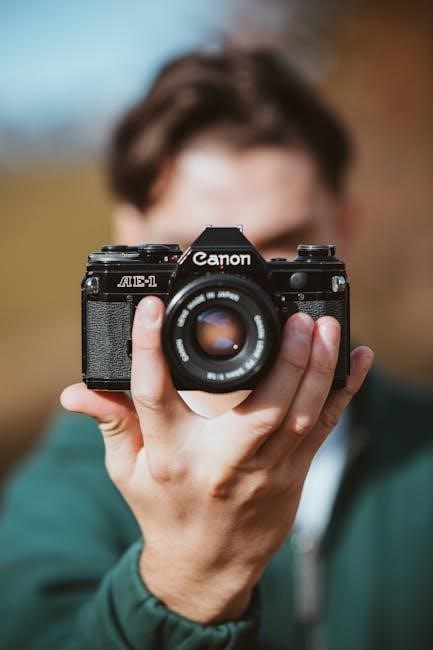
Camera Specifications and Features
The Canon AE-1 Program is a 35mm SLR with a Central Processing Unit, offering Program, Shutter-Speed Priority, and Manual modes. It features a built-in light meter, compatibility with Canon FD lenses, and a durable design.
2.1 Type and Key Characteristics
The Canon AE-1 Program is a 35mm single-lens reflex (SLR) film camera, introduced in 1981 as part of the AE-1 series. It features a Central Processing Unit (CPU) for advanced functionality, offering three operation modes: Program, Shutter-Speed Priority, and Manual. Designed for versatility, it supports Canon FD lenses, ensuring compatibility with a wide range of optics. The camera is known for its durable construction, making it a reliable choice for both amateur and professional photographers. Its electronic shutter and aperture-priority capabilities set it apart as a user-friendly yet powerful tool in film photography.
2.2 Central Processing Unit (CPU) and Advanced Features
The Canon AE-1 Program incorporates a Central Processing Unit (CPU) to manage exposure calculations and advanced features. This CPU enables seamless integration of the camera’s three operating modes: Program, Shutter-Speed Priority, and Manual. The CPU also supports the camera’s metering system, ensuring accurate exposures. Advanced features include compatibility with Canon’s dedicated flash units, such as the Speedlite 168A, and the ability to adjust settings like film speed and shutter timing. These capabilities make the AE-1 Program a versatile and user-friendly camera for photographers of all skill levels, combining automation with manual control for precise results.
2.3 Compatibility with Canon FD Lenses
The Canon AE-1 Program is fully compatible with Canon FD lenses, offering a wide range of manual-focus optics. The FD mount system allows for seamless integration with lenses such as standard zooms, wide-angle, and telephoto options. The camera’s CPU works in conjunction with FD lenses to ensure accurate metering and aperture control. This compatibility makes the AE-1 Program highly versatile, catering to photographers who prefer the precision of manual-focus lenses while benefiting from advanced electronic controls. The FD lens system remains a cornerstone of the camera’s appeal, providing flexibility for various photographic applications.
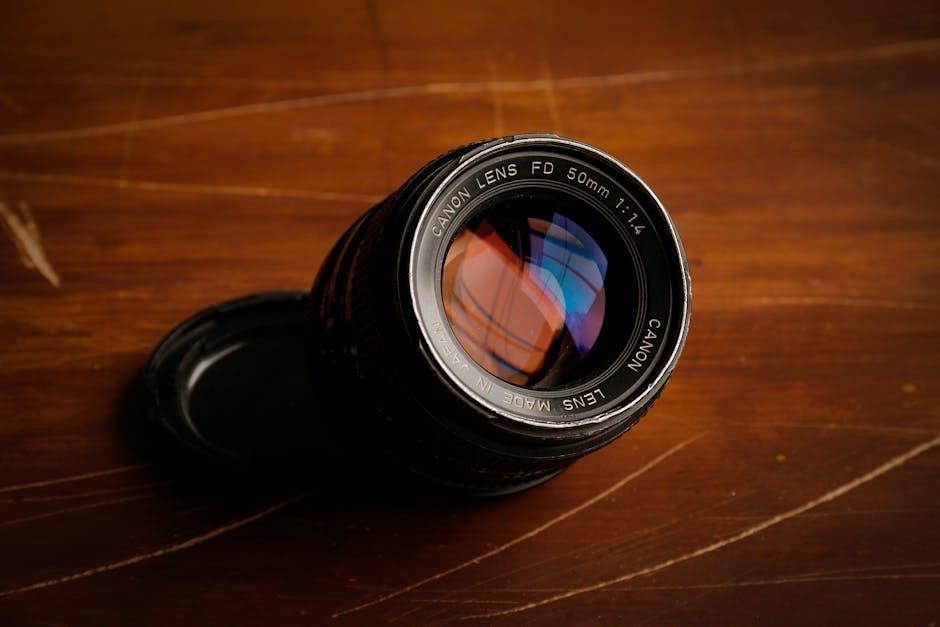
Operating Modes of the Canon AE-1 Program
The Canon AE-1 Program offers three operating modes: Program (automatic shutter and aperture), Shutter-Speed Priority, and Manual, providing photographers with flexible control over exposures for diverse shooting scenarios.
3.1 Program Mode (Automatic Shutter Speed and Aperture)
The Program Mode on the Canon AE-1 Program offers fully automatic exposure control, making it ideal for beginners or quick shooting situations. To activate this mode, set the aperture ring to “Auto” and the mode dial to “Program.” The camera’s Central Processing Unit (CPU) automatically selects both the shutter speed and aperture for optimal exposure. A “P” LED in the viewfinder confirms the mode is active. This mode eliminates manual adjustments, allowing photographers to focus solely on composition and subject capture, ensuring sharp and well-exposed images with minimal effort.
3.2 Shutter-Speed Priority Mode
In Shutter-Speed Priority mode, photographers control the shutter speed while the camera automatically adjusts the aperture for proper exposure. This mode is ideal for capturing motion effects, such as freezing fast-moving subjects or creating motion blur. To activate, set the mode dial to “Tv” (Time Value) and use the shutter speed dial to select the desired speed. The camera’s CPU calculates the corresponding aperture, ensuring accurate exposure. An LED in the viewfinder displays the selected shutter speed, allowing precise control over the shooting environment and creative flexibility for various lighting conditions and subject dynamics.
3.3 Manual Mode
In Manual Mode, photographers have complete control over both shutter speed and aperture settings, allowing for precise creative control. The camera’s CPU does not assist in this mode, making it ideal for experienced users who want full manual operation. To use Manual Mode, set the mode dial to “M” and adjust the aperture and shutter speed independently. The viewfinder displays a meter needle to help guide manual settings, ensuring proper exposure. This mode is particularly useful for fine-tuning exposure in challenging lighting conditions or for achieving specific artistic effects, offering unparalleled flexibility for advanced photographers.

Key Features and Controls
The Canon AE-1 Program features a built-in metering system, manual controls, and a clear viewfinder for precise composition. Battery-powered, it offers intuitive dials for mode selection and adjustments.
4.1 Viewfinder and Metering System
The Canon AE-1 Program features a bright, high-eyepoint viewfinder with a micro prism for precise focusing. It includes a built-in metering system, providing accurate exposure readings. The viewfinder displays key information such as aperture, shutter speed, and battery status. The metering system is center-weighted, ensuring balanced exposures in various lighting conditions. A convenient LED indicator alerts users to potential overexposure or underexposure, aiding in manual adjustments. The clear, ergonomic design of the viewfinder and metering system enhances user experience, making it easier to compose and capture images effectively.
4.2 Film Loading and Advance Mechanism
Loading film into the Canon AE-1 Program is straightforward. Open the back by pulling the film rewind knob. Align the film leader with the guide, ensuring it fits securely. Close the back and advance the film using the film advance lever until it stops. The camera features a manual film advance mechanism, requiring users to cock the shutter each time. A frame counter tracks exposures, resetting automatically when the film is rewound. The camera supports film speeds from ASA 12 to 3200, with a dedicated dial for setting sensitivity. A low battery warning prevents improper loading due to insufficient power.
4.3 Battery and Power Management
The Canon AE-1 Program operates on a single 6V silver oxide battery (SR44 or LR44 type). Ensure the correct battery type is used for optimal performance. Improper batteries may cause malfunctions. The battery powers the camera’s electronic shutter, metering system, and LCD displays. Battery life averages one year with normal use. A low battery indicator appears in the viewfinder when power is depleted. Replace the battery promptly to avoid interrupted shooting. The camera’s manual film advance mechanism minimizes battery consumption, making it reliable for extended use without power issues.

Using the Camera
The Canon AE-1 Program simplifies photography with its intuitive design. Load film, set the mode, and frame shots using the bright viewfinder. Basic controls ensure easy operation.
5.1 Basic Controls and Setup
Mastering the Canon AE-1 Program begins with understanding its essential controls. Start by installing the 4LR44 battery and setting the film speed using the ASA dial. Next, choose your desired mode: Program (auto), Shutter-Speed Priority, or Manual. In Program mode, set the diaphragm ring to “Auto” and the speed knob to “P.” The viewfinder displays key settings, including the P LED for Program mode. Familiarize yourself with the aperture ring, shutter speed dial, and focus ring for precise control. Ensure the film is loaded correctly and advance it using the film advance lever. These steps ensure a smooth setup for capturing stunning images.
5.2 Loading and Shooting with Film
Loading film into the Canon AE-1 Program is straightforward. Open the camera back by pulling the film rewind knob. Align the film leader with the spool and gently advance it until it engages. Close the back and advance the film to frame 1 using the film advance lever. Set the ASA/ISO dial to match your film speed. In Program mode, the viewfinder will display the P LED when the shutter button is pressed halfway. Press the shutter to capture your image, then advance the film for the next shot. Always ensure the film counter aligns with the start mark for accurate shooting.
5.3 Understanding Error Messages and Indicators
The Canon AE-1 Program features several indicators to guide users. The P LED in the viewfinder illuminates in Program mode when the shutter button is pressed halfway, confirming proper operation. A blinking P LED indicates incorrect film speed settings. The battery check button blinks if battery power is low. If the film counter shows a blank or incorrect number, it may signal improper loading or a faulty counter. Always refer to the manual for troubleshooting specific error messages to ensure optimal camera performance and avoid missed shots due to misconfiguration or low power. Proper understanding of these indicators enhances shooting efficiency and reliability.
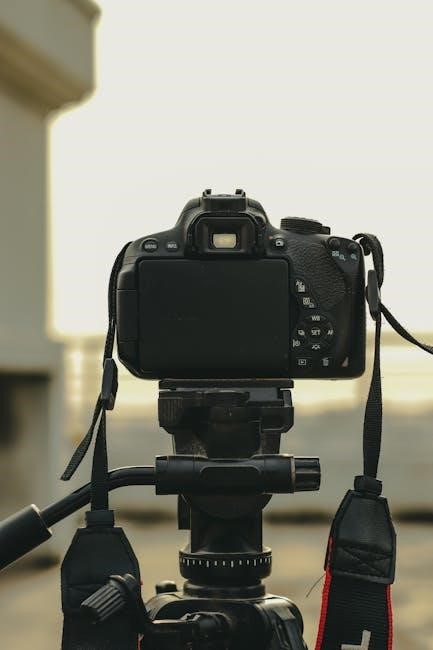
Accessories and Enhancements
The Canon AE-1 Program supports various accessories, including the Speedlite 168A flash unit, remote shutter releases, and optional FD lenses, enhancing its versatility for diverse photography needs.
6.1 Dedicated Flash Units (e.g., Speedlite 168A)
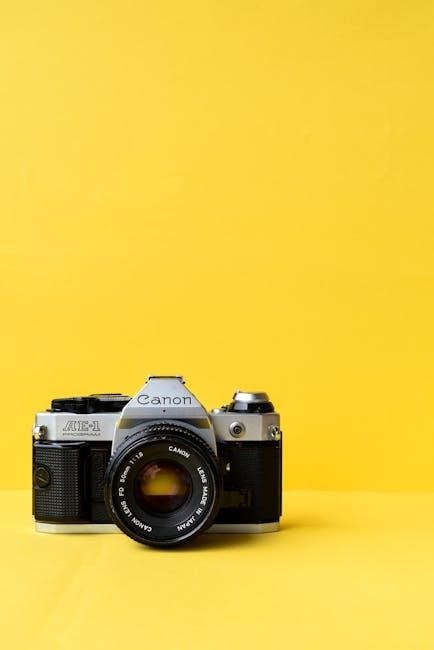
The Canon Speedlite 168A is a dedicated flash unit designed for the AE-1 Program, offering advanced flash photography capabilities. It automatically adjusts shutter speed to 1/60th of a second and sets the aperture to match the lens’s maximum aperture when attached. The flash unit integrates seamlessly with the camera’s CPU, ensuring accurate exposures without manual calculations. This accessory is ideal for low-light conditions and provides balanced lighting for professional-quality results. It is a must-have for photographers seeking to expand their creative options with the AE-1 Program.
6.2 Remote Shutter Release and Additional Accessories
The Canon AE-1 Program supports a variety of accessories to enhance functionality and convenience. A remote shutter release minimizes camera shake during exposures, ideal for long exposures or macro photography. Additional accessories include neck straps, lens cases, and optional winder units for faster film advance. These accessories integrate seamlessly with the camera’s design, offering photographers greater flexibility and control. They are designed to complement the AE-1 Program’s advanced features, ensuring a more versatile and enjoyable shooting experience. These tools cater to both amateur and professional photographers, enhancing creativity and precision.
6.3 Optional Lenses and Equipment
The Canon AE-1 Program is compatible with a wide range of Canon FD lenses, offering versatility for diverse photography needs. Optional lenses include wide-angle, telephoto, and macro lenses, each designed to enhance creativity and precision. Additional equipment, such as the Speedlite 168A flash, provides advanced lighting control. These lenses and accessories integrate seamlessly with the camera’s CPU, ensuring optimal performance in various shooting conditions. Photographers can expand their capabilities with these optional components, making the AE-1 Program a highly adaptable and powerful tool for both amateur and professional use.
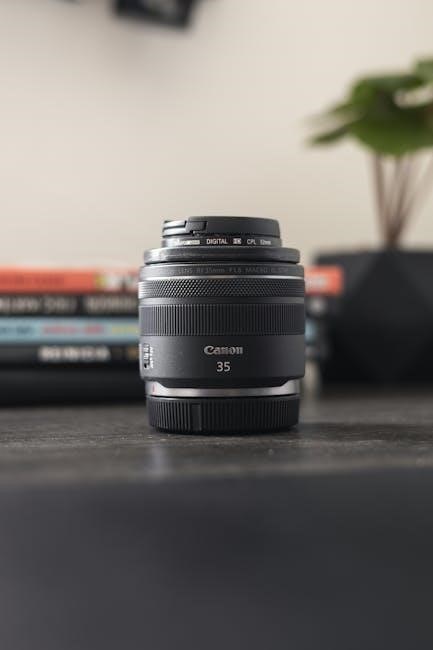
Maintenance and Care
Regular cleaning of the camera and lens is essential for optimal performance. Store the camera in a dry, cool place to prevent damage. Use a soft cloth to wipe surfaces and avoid harsh chemicals. Proper handling ensures longevity and functionality of the Canon AE-1 Program.
7.1 Cleaning the Camera and Lens
Regular cleaning is crucial for maintaining the performance and longevity of the Canon AE-1 Program. Use a soft, dry cloth to gently wipe the camera body and external surfaces, avoiding harsh chemicals. For the lens, employ a microfiber cloth and lens cleaning solution, ensuring no residue remains. Avoid touching the lens surface to prevent smudging. Store the camera in a dry, cool environment to minimize dust and moisture exposure. Proper handling and cleaning routines will preserve the camera’s functionality and image quality over time.
7.2 Lubrication and Servicing
Regular lubrication of the Canon AE-1 Program is essential to maintain smooth operation of its mechanical components. Use a high-quality synthetic grease for moving parts like the shutter and film advance mechanism, but avoid over-lubrication to prevent damage. Servicing should be performed by a qualified technician to ensure proper adjustment of internal mechanisms. The camera’s CPU and metering system require precise calibration, and improper handling can lead to malfunctions. Periodic servicing is recommended to maintain optimal performance and extend the camera’s lifespan. Detailed servicing procedures can be found in the official service manual or through authorized Canon service centers.
7.3 Proper Storage and Handling
Proper storage and handling of the Canon AE-1 Program are crucial to maintain its functionality and longevity; Store the camera in a cool, dry place, away from direct sunlight and moisture. Avoid exposing it to extreme temperatures or humidity, as this can damage the internal electronics and mechanical components. Use silica gel packets to absorb moisture in storage. Always handle the camera and lens with care, avoiding scratches or impacts. Store the camera in its protective case when not in use to prevent dust and damage. Regularly clean the lens and viewfinder to ensure optimal performance.
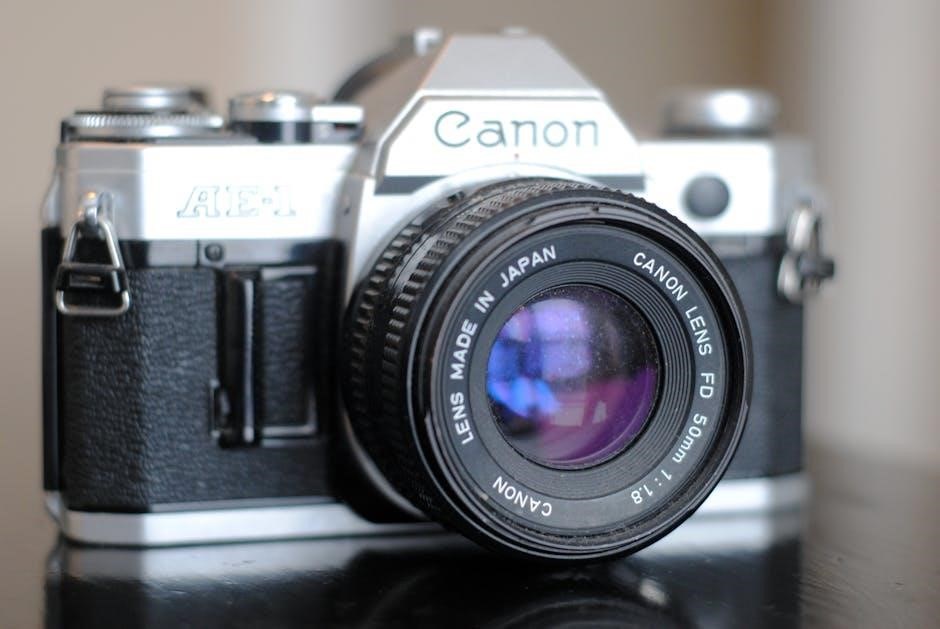
Common Issues and Troubleshooting
The Canon AE-1 Program may experience issues like shutter malfunctions or metering inaccuracies. Regular cleaning and proper maintenance can often resolve these problems. Consult the manual for solutions.
8.1 Shutter Malfunctions and Adjustments
The Canon AE-1 Program may experience shutter malfunctions, such as slow or stuck shutters, often due to mechanical wear or improper adjustments. Symptoms include inconsistent exposures or error messages like “E” or “0.” Cleaning the shutter mechanism and ensuring proper battery power can resolve some issues. Adjustments should be done carefully, as improper settings may worsen malfunctions. If problems persist, professional servicing is recommended to maintain optimal performance and prevent further damage to the camera’s internal components. Regular maintenance and proper handling can help prevent these issues and extend the camera’s lifespan.
8.2 Metering System Problems
The Canon AE-1 Program metering system may encounter issues like inaccurate exposures or “E” error messages, often due to dirt or corrosion on electrical contacts. Clean the battery compartment and lens contacts to resolve connectivity problems. If metering remains inconsistent, check for obstructions in the light-sensitive areas or faulty microprocessors. Ensure proper battery power, as low voltage can disrupt metering accuracy. For severe issues, consult the Canon AE-1 Program manual or contact a professional technician to restore proper functionality and maintain precise exposure control. Regular maintenance can prevent such issues and ensure reliable performance.
8.3 Battery Drain and Power Issues
Battery drain and power issues in the Canon AE-1 Program often stem from improper battery installation, corrosion, or using the wrong battery type. Always use a 6V silver oxide battery to ensure optimal performance. If the battery drains quickly, avoid leaving it in the camera for extended periods. Corrosion in the battery compartment can disrupt power flow; clean terminals with a soft cloth and vinegar. Excessive use of features like the self-timer or flash can also drain power faster. Refer to the Canon AE-1 Program manual for guidelines on proper battery care and replacement to maintain reliable operation.
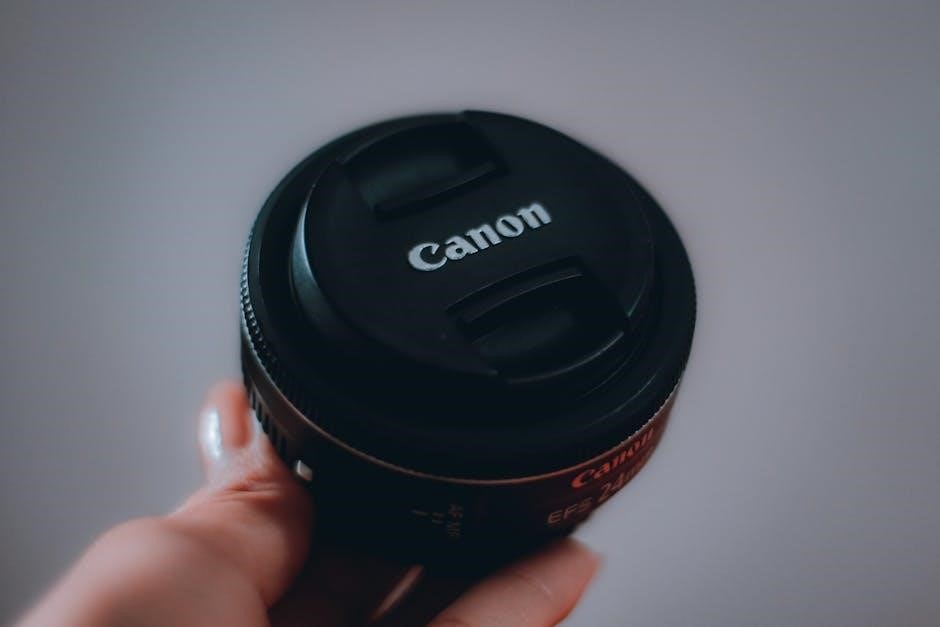
Advanced Techniques and Settings
The Canon AE-1 Program supports advanced techniques like bracketing for exposure control, multiple exposures for creative effects, and long exposure settings for nighttime or artistic photography.
9.1 Using Aperture Priority and Manual Modes
The Canon AE-1 Program offers Aperture Priority and Manual modes for precise control over exposures. In Aperture Priority, set the aperture, and the camera adjusts the shutter speed automatically. For Manual mode, both aperture and shutter speed are manually adjustable, allowing full creative control. To use these modes, turn the diaphragm-setting ring to the desired aperture and adjust the speed knob as needed. The LED in the viewfinder will confirm the selected settings. These modes are ideal for photographers seeking flexibility and customization in their shots, enabling advanced techniques like depth-of-field manipulation and intentional overexposure or underexposure for artistic effects.
9.2 Bracketing and Multiple Exposures
Bracketing and multiple exposures on the Canon AE-1 Program allow photographers to capture a range of creative effects. Bracketing involves taking multiple shots at different exposures to ensure optimal results in varying lighting conditions. Multiple exposures enable capturing several images on a single frame for artistic effects. To achieve this, disable the film advance mechanism and shoot without winding the film. These techniques require manual mode for full control over aperture and shutter speed. Bracketing is ideal for high-contrast scenes, while multiple exposures offer unique creative possibilities, making the AE-1 Program versatile for advanced photography techniques.
9.3 Long Exposure and Nighttime Photography
The Canon AE-1 Program excels in long exposure and nighttime photography, offering precise control for capturing low-light scenes. Use the self-timer or a remote shutter release to minimize camera shake. In Manual mode, set long shutter speeds (up to 8 seconds) or use the Bulb (B) mode for exposures beyond 8 seconds. A tripod is essential for stability. For nighttime photography, experiment with wide apertures and slow shutter speeds to capture star trails or city lights. These features make the AE-1 Program a versatile tool for creative low-light photography, ensuring sharp and well-exposed results. Proper technique and patience are key to mastering these techniques.
The Canon AE-1 Program remains a landmark camera, blending simplicity with advanced features. For detailed operation, refer to the official Canon AE-1 Program PDF manual, available online.
10.1 Summary of Key Features and Benefits
The Canon AE-1 Program stands out for its versatility, offering three operational modes: Program, Shutter-Speed Priority, and Manual. It features a Central Processing Unit (CPU) for advanced metering and automatic adjustments. The camera supports Canon FD lenses and includes compatibility with dedicated flash units like the Speedlite 168A. Its durable design and user-friendly interface make it accessible to both amateurs and professionals. The optional Power Winder enhances convenience, allowing for seamless film advancement. With its robust features and reliable performance, the AE-1 Program remains a favorite among film photography enthusiasts, providing excellent value and functionality.
10.2 Importance of the Canon AE-1 Program in Photography
The Canon AE-1 Program holds significant importance in photography history as a bridge between amateur and professional cameras. Released in 1981, it introduced advanced features like Programmed AE mode, making it accessible to a broader audience. Its durability, intuitive design, and compatibility with Canon FD lenses solidified its reputation. The camera played a crucial role in photography education, teaching users about aperture, shutter speed, and manual controls. Its impact lies in democratizing advanced photography techniques, inspiring a generation of photographers. Today, it remains a cherished tool for film enthusiasts, blending nostalgia with functional excellence.
10.3 Accessing the Full PDF Manual
The full Canon AE-1 Program PDF manual is available for download from various online sources, including official Canon websites and third-party repositories. Users can access the manual in multiple languages, such as English or Spanish, depending on the source. The manual provides detailed instructions on camera operation, maintenance, and troubleshooting. It also includes specifications, advanced techniques, and disassembly instructions for servicing. To view the PDF, Adobe Reader or similar software is required. The manual is a valuable resource for both beginners and experienced photographers, ensuring optimal use of the camera’s features and longevity. Download links are widely available online.


